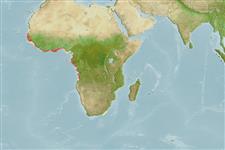>
Gobiiformes (Gobies) >
Gobiidae (Gobies) > Gobiinae
Etymology: Thorogobius: Greek, thoros = semen + Latin, gobius = gudgeon (Ref. 45335); laureatus: Name from Latin 'laureatus' meaning crowned with a laurel; referring to the shape of the scaled areas in the predorsal region..
Environment: milieu / climate zone / depth range / distribution range
Ecologia
marino; distribuzione batimetrica 57 - 109 m (Ref. 118185). Tropical
Distribuzione
Stati | Aree FAO | Ecosystems | Presenze | Point map | Introduzioni | Faunafri
Eastern Atlantic: Angola and São Tomé and Príncipe.
Size / Peso / Age
Maturity: Lm ? range ? - ? cm
Max length : 7.4 cm SL maschio/sesso non determinato; (Ref. 118185); 8.0 cm SL (female)
Short description
Chiavi di identificazione | Morfologia | Morfometria
Spine dorsali (totale) : 7; Raggi dorsali molli (totale) : 11; Spine anali: 1; Raggi anali molli: 10; Vertebre: 28. This species is distinguished from its congeners in the combination of following characters: D1 VI (second and third distinctly elongated); pectoral fin rays 19-22; short pelvic disc complete with well-developed anterior membrane (frenum), pointed lateral lobes; scales on nape and predorsal area in lateral band; opercle no scales; scales in longitudinal series 24-27; supratemporal rows tr and trp developed and extending transversally between pores H and K; longitudinal row g is long, passing row m posteriorly and relatively close to row h; infraorbital row 6 is long, ventrally extending to lower margin of preopercle, its ventral (6i) and dorsal (6s) originating opposite to each other; posterior lateral row h is long, reaching anteriorly above middle of opercle; body depth 18.9-23.8% at anal-fin origin in SL, head width 48.5-56.0% in HL; long upper jaw 41.8-58.0% in HL; minimum height of caudal peduncle 45.1-59.8% in caudal peduncle length; large eyes 23.9-30.9% in HL); long caudal fin 27.9-35.5% in SL; body pale fawn and brownish with margin of scale pockets dark brown pigmented, yielding a reticulated pattern; 5 brown blotches on flanks in lateral midline from below first dorsal fin to caudal peduncle; caudal fin with 6-7 distinct dark vertical bands (Ref. 118185).
Specimens were dredged on the upper slope of the continental shelf from soft bottom (Ref. 118185).
Life cycle and mating behavior
Maturities | Riproduzione | Spawnings | Egg(s) | Fecundities | Larve
Sauberer, M., T. Iwamoto and H. Ahnelt, 2018. Two new deep-water species of the genus Thorogobius (Teleostei: Gobiidae) from the upper continental slope of the Eastern Central Atlantic. Zootaxa 4429(2):357-371. (Ref. 118185)
IUCN Red List Status (Ref. 130435)
Threat to humans
Harmless
Human uses
Strumenti
Special reports
Download XML
Fonti Internet
Estimates based on models
Phylogenetic diversity index (Ref.
82804): PD
50 = 0.5156 [Uniqueness, from 0.5 = low to 2.0 = high].
Bayesian length-weight: a=0.00708 (0.00333 - 0.01504), b=3.09 (2.92 - 3.26), in cm total length, based on LWR estimates for this (Sub)family-body shape (Ref.
93245).
Trophic level (Ref.
69278): 3.3 ±0.4 se; based on size and trophs of closest relatives
Resilienza (Ref.
120179): Alto, tempo minimo di raddoppiamento della popolazione meno di 15 mesi (Preliminary K or Fecundity.).
Fishing Vulnerability (Ref.
59153): Low vulnerability (10 of 100).
